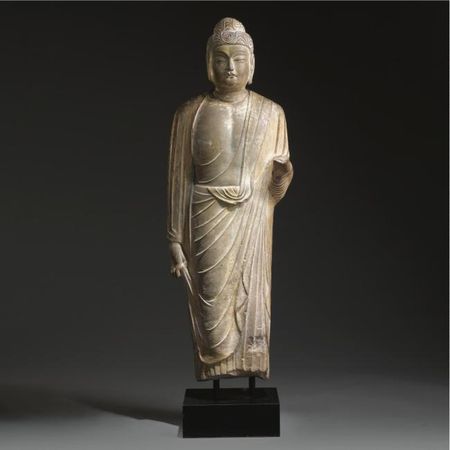An outstanding carved sandstone figure of Buddha, Tang Dynasty, 8th Century
An outstanding carved sandstone figure of Buddha, Tang Dynasty, 8th Century
the robust figure boldly conceived in the round with full volumes visible under the thin robes, the deity standing upright on long slender legs with the left arm bent up at the elbow and the right arm held loosely down to grasp the folds of his diaphanous robes in the elongated and finely shaped fingers, the folds of the robes all finely delineated in rhythmic draped swathes curling around the bent left arm and draped down across the body to a short tuck at the waist, and left loosely draped down along the right arm leaving the stylized rounded volumes of the chest bare, the head held up on the thick neck, the features finely carved with arching brows, large bow-shaped eyes, small nose, and tight bud mouth with bow shaped lips, flanked by large ears with pendulous earlobes and framed by the hair with high domed ushnisha, the folds of the hair depicted in undulating scalloped waves, progressing around the head in rhythmic pattern, leaving a tight whorl in the center representing the urna, the pinkish grey sandstone now exhibiting an even and glossy patina with ample traces of white undercoat, red and gold pigments with accents of blue and black (stand). height 42 1/2 in., 108 cm. Estimate 200,000—300,000 USD
PROVENANCE: Otto W. Burchard, Berlin.
Sotheby's London, 21st June 1983, lot 69.
The Chinese Porcelain Company, New York, 1991.
Sotheby's New York, 18th September 1996, lot 273.
EXHIBITED: Ancient Asian Sculpture, The Chinese Porcelain Company, New York, 1991, cat.no.13.
NOTE: This figure is remarkable for the subtle representation of the drapery, especially where the garment is picked up by the Buddha's hand. It is very rare to find a standing figure of similar style and quality, although several seated Buddha figures are closely related, particularly one in the Art Institute of Chicago, dated in accordance with AD 706, and another in the Shôdo Hakubutsukan, dated in accordance with AD 711, both illustrated in Hai-wai yi-chen/Chinese Art in Overseas Collections: Buddhist Sculpture, vol.2, Taipei, 1990, pls.102 and 103.
Compare also a Buddha head from the Longmen Caves in the Osaka Municipal Art Museum, included in the Museum's exhibition Chinese Buddhist Stone Sculpture: Veneration of the Sublime, Osaka, 1995, cat.no.56, which is very similar in style, also not carved fully in the round but backing onto a wall.
Sotheby's. Chinese Works of Art. 17 Mar 09.New York www.sothebys.com Photo courtesy Sotheby's

/https%3A%2F%2Fprofilepics.canalblog.com%2Fprofilepics%2F1%2F0%2F100183.jpg)



/http%3A%2F%2Fstorage.canalblog.com%2F79%2F46%2F577050%2F66001994_o.jpg)
/http%3A%2F%2Fstorage.canalblog.com%2F40%2F54%2F119589%2F65372473_p.jpg)
/http%3A%2F%2Fstorage.canalblog.com%2F01%2F26%2F577050%2F64298659_o.jpg)
/http%3A%2F%2Fstorage.canalblog.com%2F40%2F89%2F577050%2F63638297_o.jpg)